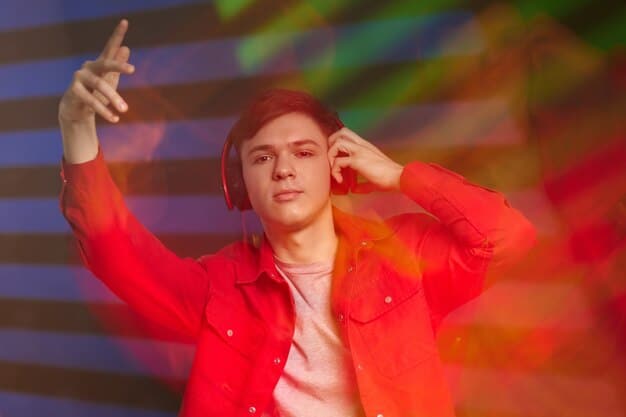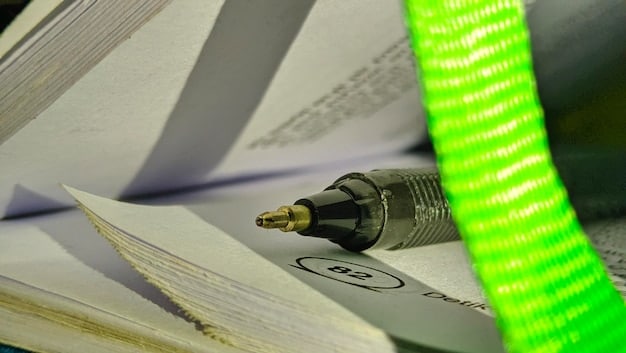J-Pop Music Licensing in the US: 2025 Copyright Guide

J-Pop Music Licensing: How Are Artists Navigating US Copyright Laws in 2025? The US Copyright Law significantly impacts J-Pop artists, dictating royalty payments, performance rights, and how their music can be used in various formats. Navigating these complexities in 2025 requires strategic planning, legal expertise, and an understanding of digital music distribution.
The vibrant world of J-Pop continues to captivate audiences globally, but navigating the intricacies of US copyright law can be a daunting task for artists. Understanding the nuances of music licensing is crucial for protecting creative work and ensuring fair compensation in the ever-evolving digital landscape. Let’s explore how J-Pop Music Licensing: How Are Artists Navigating US Copyright Laws in 2025?
Understanding US Copyright Law for J-Pop Artists
US copyright law protects original works of authorship, including musical compositions and sound recordings. For J-Pop artists, understanding these protections is essential for controlling who can use their music and how they are compensated.
Copyright Ownership
Copyright initially vests in the author or authors of the work. In the case of J-Pop music, this typically includes the songwriter(s) and the performer(s). Understanding the roles and rights of each contributor is vital for proper licensing.
Exclusive Rights of Copyright Holders
Copyright owners have exclusive rights, including the right to reproduce the work, distribute copies, perform the work publicly, and create derivative works. These rights are the foundation for music licensing agreements.
- Right to Reproduce: Control over making copies of the music.
- Right to Distribute: Control over selling or otherwise transferring ownership of the music.
- Right to Perform Publicly: Control over live performances and streaming through platforms like radio or online services.
- Right to Create Derivative Works: Adaptations, remixes, or translations of the original song.
Navigating these rights requires a thorough understanding of US legal frameworks and how they apply specifically to foreign artistic works. This knowledge enables J-Pop artists to effectively safeguard their creative output and ensure equitable compensation for its usage across various platforms and mediums.
Music Licensing Basics for J-Pop
Music licensing is the process of granting permission to another party to use copyrighted music. For J-Pop artists, understanding the different types of licenses and how they work in the US is crucial.
Types of Music Licenses
There are several types of music licenses relevant to J-Pop artists, including mechanical licenses, performance licenses, synchronization licenses, and master use licenses.
Mechanical Licenses
Mechanical licenses grant permission to reproduce and distribute a song on physical media (like CDs) or digitally (like downloads). These licenses are typically handled by organizations like the Harry Fox Agency in the US.
Performance Licenses
Performance licenses allow for the public performance of a song, whether live or through broadcast media. These licenses are managed by Performing Rights Organizations (PROs) such as ASCAP, BMI, and SESAC in the US.
- ASCAP (American Society of Composers, Authors and Publishers): One of the main PROs in the U.S.
- BMI (Broadcast Music, Inc.): Another leading PRO that collects and distributes performance royalties.
- SESAC (Society of European Stage Authors and Composers): A PRO known for its selective membership.
Understanding these categories helps artists pinpoint where and how they earn royalties, ensuring they’re justly compensated whenever their music is played publicly.

Navigating Performance Rights Organizations as a J-Pop Artist
Performance Rights Organizations (PROs) such as ASCAP, BMI, and SESAC play a pivotal role in collecting and distributing royalties for public performances of J-Pop music in the US. For J-Pop artists, affiliating with a PRO is essential for ensuring they receive fair compensation when their music is played publicly.
How PROs Work
PROs monitor public performances of music and collect royalties from broadcasters, venues, and digital streaming services like Spotify and Apple Music. They then distribute these royalties to their affiliated songwriters and publishers.
Affiliating with a PRO
J-Pop artists can affiliate with a PRO in the US to ensure their songs are tracked and royalties are collected accurately. Each PRO has its own membership requirements and fee structures.
Direct Licensing
Direct licensing involves negotiating performance rights directly with venues or digital services. While less common, this approach allows for greater control over the licensing process.
When considering whether to affiliate with a PRO or pursue direct licensing, J-Pop artists should evaluate the administrative overhead, royalty rates, and potential for maximizing revenue. Ultimately, the best approach will depend on the artist’s specific circumstances, market size, and objectives within the US music industry.
Synchronization and Master Use Licenses
Synchronization and master use licenses are crucial for J-Pop artists seeking to have their music featured in films, TV shows, video games, and commercials in the US. These licenses govern the use of both the musical composition (synchronization) and the sound recording (master use).
Synchronization Licenses
A synchronization license grants permission to synchronize a musical composition with visual media. This license is obtained from the copyright owner of the song, typically the music publisher or songwriter.
Master Use Licenses
A master use license grants permission to use a specific recording of a song in visual media. This license is obtained from the copyright owner of the sound recording, typically the record label or artist.
Royalty Agreements
Royalty agreements specify the terms of payment for the use of the music. These agreements can vary widely depending on factors like the popularity of the artist and the scope of the use.
- Negotiating Fees: Understand fair market rates and negotiate effectively.
- Defining Scope: Clearly specify how the music can be used.
- Term Lengths: Establish the duration of the license agreement.
Negotiating both licenses effectively is crucial, as the fees can substantially impact a J-Pop artist’s earnings. It’s advisable for artists to seek guidance from legal experts experienced in the complexities of synchronization and master use licenses to secure favorable terms. Expertise in this area ensures artists are fairly compensated when their music is featured in visual media within the US market.
Digital Distribution and Streaming Rights
Digital distribution and streaming services have revolutionized how music is consumed, creating new opportunities and challenges for J-Pop artists. Understanding the licensing implications of digital distribution is crucial for maximizing revenue and protecting copyright in the digital age.
Digital Music Platforms
Platforms like Spotify, Apple Music, and Amazon Music require licenses to stream J-Pop music to their users. These licenses are typically negotiated with record labels or rights management organizations.
Streaming Royalties
Streaming royalties are payments made to copyright owners for the use of their music on streaming services. The royalty rates can vary depending on the service and the country.
Challenges and Copyright Infringement
The digital age has also brought new challenges, including piracy and unauthorized use of J-Pop music. Copyright owners must actively monitor and enforce their rights to combat infringement.
To optimize earning potential, J-Pop artists should focus on engaging with fans, understanding digital marketing, and closely monitoring data analytics. By leveraging these strategies, artists can boost streams and increase revenue while staying vigilant about protecting their intellectual property rights in the dynamic digital marketplace.
Future Trends in J-Pop Music Licensing in the US
As technology continues to evolve, the landscape of music licensing will continue to change. For J-Pop artists, staying informed about future trends and adapting to new technologies is essential for success.
Blockchain Technology
Artificial Intelligence
AI is being used to analyze music and identify potential copyright infringements. AI tools are also being used to create new music, raising complex questions about authorship and ownership.
The Metaverse
The metaverse presents new opportunities for J-Pop artists to connect with fans and monetize their music. However, it also raises complex licensing issues related to virtual performances and digital ownership.
- Virtual Concerts: Opportunities for live performances in virtual spaces.
- NFTs (Non-Fungible Tokens): Tokenized assets representing ownership of unique digital content.
- Digital Rights Management: Systems for protecting digital content from unauthorized use.
Adapting to these trends will require innovative approaches to licensing, distribution, and artist-fan interactions. J-Pop artists who embrace these technologies strategically will be positioned to thrive in the evolving music industry landscape.
| Key Point | Brief Description |
|---|---|
| 🎶 Copyright Law | Protects music, controlling who can use the work. |
| 🎵 Music Licensing | Permissions to use copyrighted music legally. |
| 🎤 PRO Affiliation | Essential for royalty collection via ASCAP, BMI, SESAC. |
| 🎬 Sync Licensing | Crucial for music in films, TV, and games in the U.S. |
Frequently Asked Questions
▼
Copyright law protects original musical works from unauthorized use. For J-Pop artists, it ensures they control how their music is reproduced, distributed, and performed, securing their creative and financial rights.
▼
Key licenses include mechanical licenses for reproduction, performance licenses for public performances, synchronization licenses for use in visual media, and master use licenses for using specific recordings.
▼
PROs like ASCAP, BMI, and SESAC collect royalties for public performances of music. They monitor usage, collect fees from broadcasters and venues, and distribute royalties to their affiliated artists.
▼
A synchronization license is needed when music is synchronized with visual media such as films, TV shows, or video games. It grants permission to integrate the musical composition with visual content.
▼
They can protect their music by registering copyrights, monitoring online platforms for unauthorized use, using digital rights management tools, and affiliating with PROs to track and collect royalties from streaming services.
Conclusion
Navigating US copyright laws in 2025 presents both challenges and opportunities for J-Pop artists. By understanding the complexities of music licensing, affiliating with performance rights organizations, and staying informed about future trends, J-Pop artists can protect their creative work and thrive in the global music market.





